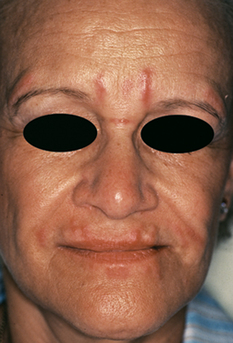Chapter 13 Granulomatous diseases of the skin
1. What is meant by “granulomatous diseases of the skin”?
Quite simply, the granulomatous disorders of the skin comprise a broad category of diseases that are characterized by the accumulation of activated macrophages with an epithelioid appearance in the dermis or subcutaneous tissue. A granuloma is a distinct aggregate composed of epithelioid macrophages with or without multinucleated giant cells. These aggregates are typically surrounded by a rim of lymphocytes with plasma cells being variably present. Macrophages develop from bone marrow–derived monocytes that leave the circulation and enter the skin.
2. Explain the role of histiocytes in granulomas.
Many references use the confusing term histiocyte when discussing granulomas. Histiocyte may be used interchangeably with macrophage or monocyte, but the term is not specific and may be applied also to transformed lymphocytes (e.g., histiocytic lymphoma), fibroblasts that demonstrate phagocytosis (e.g., fibrous histiocytoma, reticulohistiocytoma), and antigen-presenting cells (e.g., histiocytosis X). Some authorities eschew the use of this term because it is not specific.
3. What is the difference between an immune granuloma and a foreign body granuloma?
Immune granuloma formation is a local tissue response to a poorly soluble substance that is capable of inducing a cell-mediated immune response (e.g., cutaneous tuberculosis). The persistent presence of a poorly soluble substance in the skin causes the activation of T cells, which secrete cytokines such as interleukin-2 (Il-2) to activate additional T cells and interferon-2 (IFN-2), which transform macrophages into epithelioid macrophages and multinucleated giant cells. In contrast, foreign body granulomas, typically are the result of larger aggregates of inert foreign material that cannot be phagocytized by a single macrophage (e.g., wood splinter). In general, granulomas are produced by infectious agents, foreign bodies, or alterations in the host immune system.
5. Can granulomas be recognized clinically?
Sometimes. Granulomas usually present as dermal nodules, although epidermal changes can be present. Foreign body granulomas may demonstrate a central erosion or ulceration secondary to an attempt by the body to extrude the foreign material through an elimination tract. Granulomas often present as nonspecific erythematous nodules; however, they also may present as dermal nodules with an “apple-jelly hue” that is highly suggestive of an underlying granulomatous process. This apple-jelly hue can frequently be better appreciated by using diascopy (applying pressure to the lesion with a glass slide).
6. How do endogenous “foreign” bodies cause granulomas?
Endogenous substances produce a granulomatous reaction when they come in contact with the dermis or subcutaneous fat. For example, one of the most common foreign body reactions occurs when an epidermoid cyst wall ruptures and its keratin contents come in contact with the dermis. Normally, the keratin within the cyst is protected from the dermis by the cyst’s epithelial lining. However, when a cyst ruptures, the keratin is exposed to the dermis and, being a poorly soluble substance, it produces a granulomatous response.
Table 13-1. Agents and Diseases That Can Produce Granulomas
| Infectious Agents | ||
| Fungi | Bacteria | Miscellaneous Infections |
| Blastomycosis Candidiasis Chromomycosis Coccidioidomycosis Cryptococcosis Histoplasmosis Sporotrichosis | Actinomycosis Cat scratch fever Granuloma inguinale (donovanosis) Mycobacterial infections Nocardiosis Syphilis Tularemia | Leishmaniasis Protothecosis (algae infection) |
| Foreign Body Agents | ||
| Exogenous | Endogenous | Miscellaneous Diseases |
| Aluminum Cosmetic fillers Hair Insect parts Paraffin Silica Splinters Starch Sutures Talc Tattoo pigment | Bone Calcium Cholesterol Keratin Hair Sebum Urate crystals | Actinic granuloma Crohn’s disease Granuloma annulare Granulomatous cheilitis Granulomatous rosacea Lupus miliaris disseminatus faciei Necrobiosis lipoidica Rheumatoid nodule Sarcoidosis |
8. Do cosmetic fillers ever produce foreign body granulomas?
Yes. Numerous cosmetic fillers, including products made from collagen (Fig. 13-2), silicone, hyaluronic acid, methacrylate, and polyalkylimide, have been reported to produce foreign body granulomas. In some cases the cosmetic results have been very poor and difficult to correct. The number of reported cases is rapidly increasing as the cosmetic filler industry has rapidly expanded in the last decade and larger numbers of patients are receiving injections for cosmetic fillers.
Table 13-2. Sources of Foreign Bodies
| AGENT | SOURCE |
|---|---|
| Silicone | Breast implants, joint prostheses, soft tissue injections, hemodialysis tubing |
| Silica | Soil and rock (very abundant), glass |
| Paraffin (oils) | Cosmetic injection (historically), factitial injection, grease gun injury |
| Starch | Surgical gloves contaminating wounds |
| Graphite | Pencil lead (see Fig. 13-1A) |
| Thorns | Roses, cactus, yucca (see Fig. 13-1B) |
| Hair | Barbers, dog groomers, sheep shearers |
| Talc | IV drug use, wound contamination |
| Aluminum | Adjuvant in DPT immunizations |
| Zirconium | Deodorant sticks |
| Beryllium | Metal, ceramic, and electronic industries; fluorescent lamp workers (historically, as this ceased in 1951) |
DPT, Diphtheria-pertussis-tetanus, IV, intravenous.
Winslow CP: The management of dermal filler complications, Facial Plast Surg 25:124–128, 2009.
Stay updated, free articles. Join our Telegram channel

Full access? Get Clinical Tree










